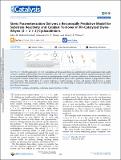Steric parameterization delivers a reciprocally predictive model for substrate reactivity and catalyst turnover in Rh-catalyzed diyne-alkyne [2+2+2] cycloadditions
Abstract
The Rh-catalyzed [2 + 2 + 2] cycloaddition of diynes and alkynes is a synthetically useful transformation that rapidly constructs complex scaffolds and has been used extensively for >70 years. Despite this utility, substrate reactivity issues persist, which are not mechanistically defined. Here, we provide a general predictive model for reactivity and turnover for this reaction. Contrary to the proposed electronic model, this is a predominately sterically driven process where productive turnover is proportional to alkyne steric parameters. This model allows for a priori prediction of catalyst loading, turnover, and reaction yield based on a simple assessment of the steric parameter (e.g., A-value) of the alkyne. The relationship is reciprocal, allowing A-values to be calculated from observed turnover.
Citation
Halford-McGuff , J , Slawin , A M Z & Watson , A J B 2023 , ' Steric parameterization delivers a reciprocally predictive model for substrate reactivity and catalyst turnover in Rh-catalyzed diyne-alkyne [2+2+2] cycloadditions ' , ACS Catalysis , vol. 13 , no. 6 , pp. 3463–3470 . https://doi.org/10.1021/acscatal.2c06300
Publication
ACS Catalysis
Status
Peer reviewed
ISSN
2155-5435Type
Journal article
Description
Funding: J.M.H.-M. thanks the EaSI-CAT CDT and the University of St Andrews for a PhD studentship. A.J.B.W. thanks the Leverhulme Trust for a Research Fellowship.Collections
Items in the St Andrews Research Repository are protected by copyright, with all rights reserved, unless otherwise indicated.

